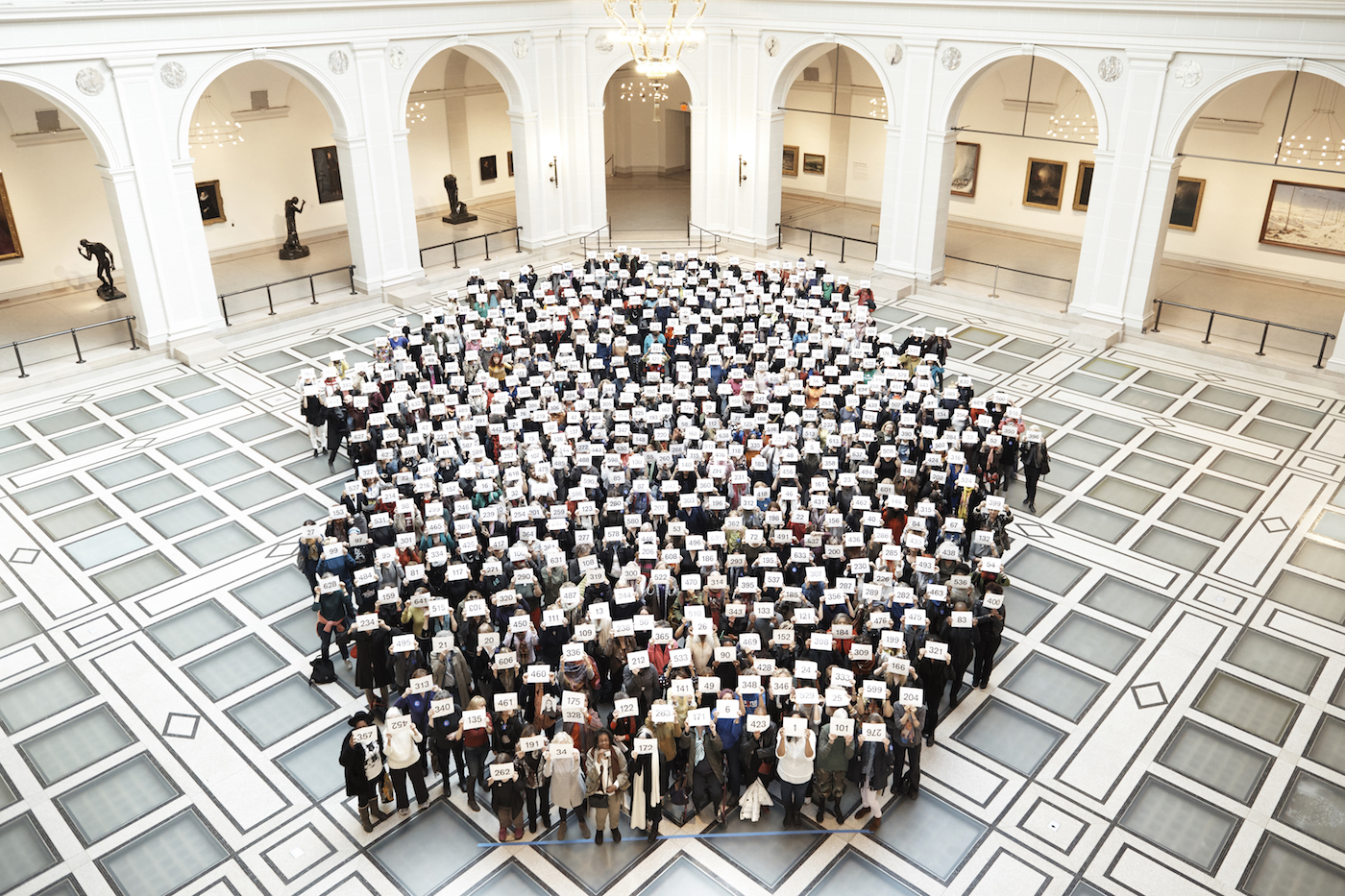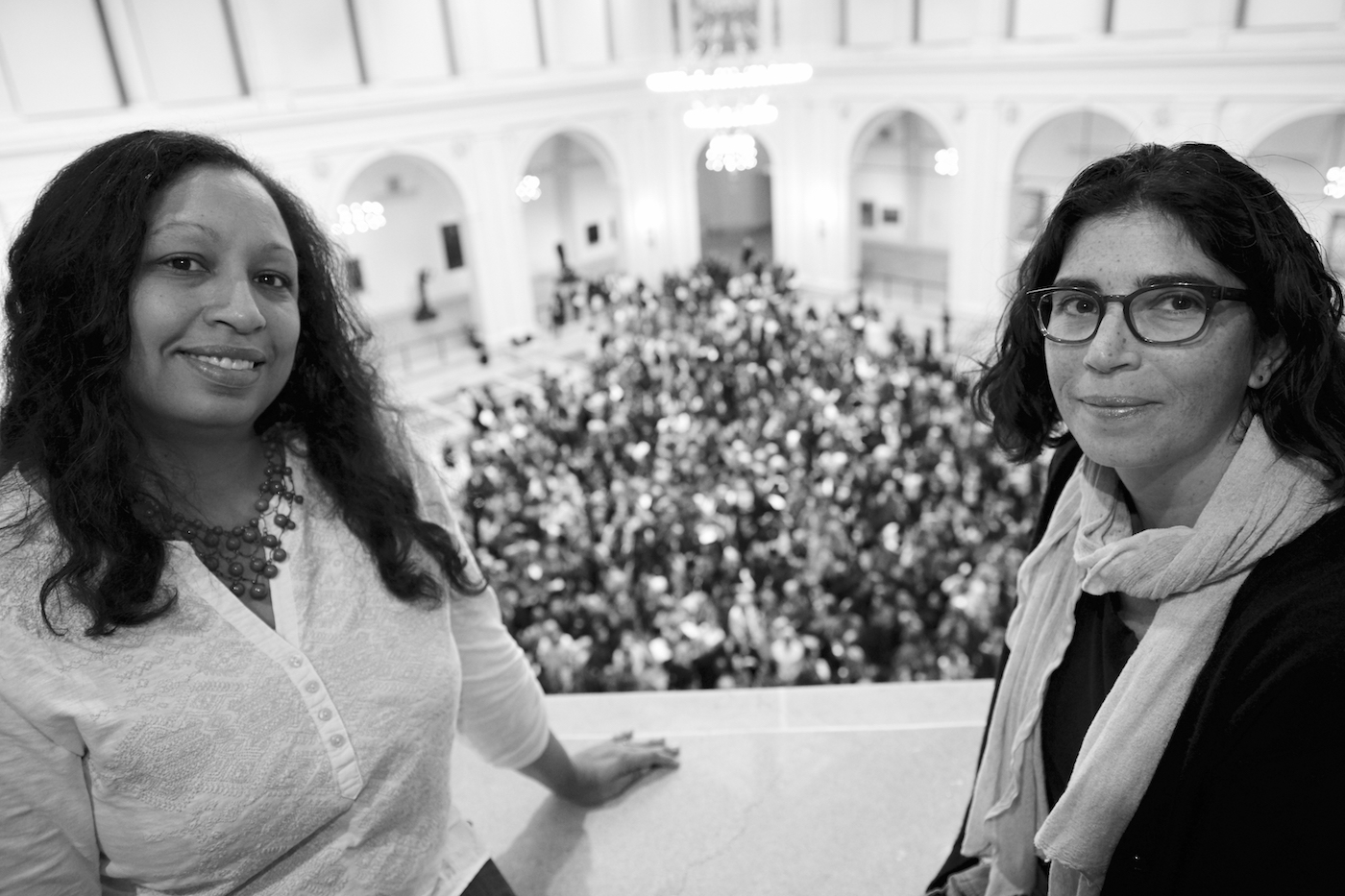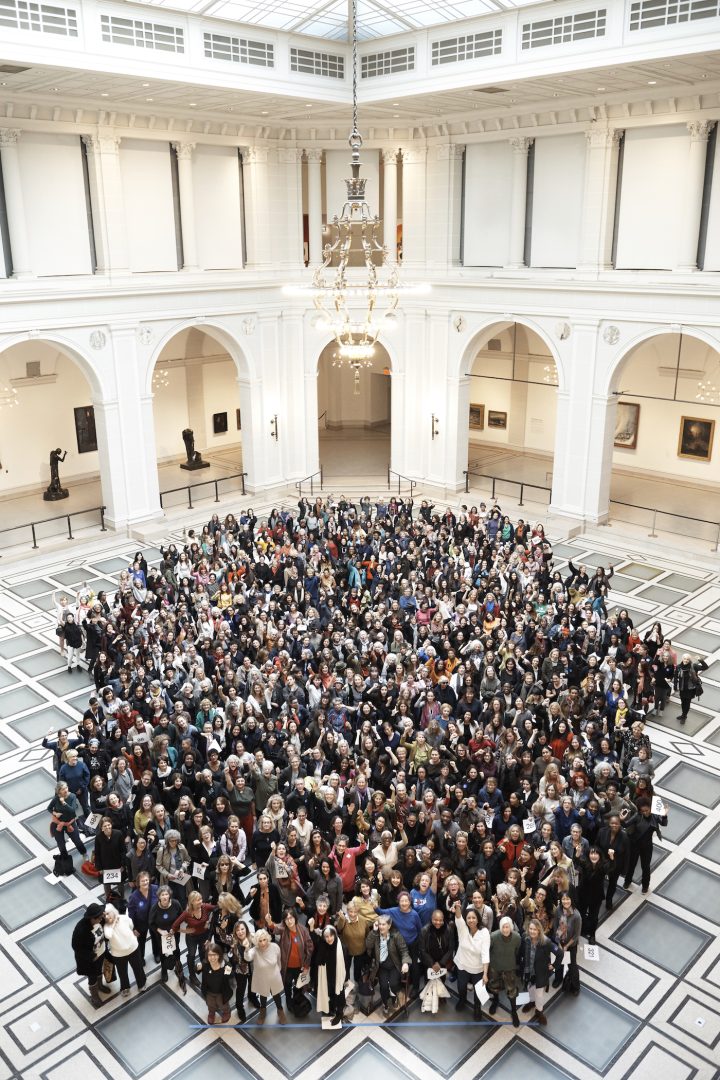In Brooklyn, 600 Women Artists Unite for a Photograph

What do you wear to be photographed with hundreds of women artists? I wore my new earrings that say “Fuck the” on the right ear and “Patriarchy” on the left ear, along with comfy leggings, a tank, blazer, and pussy-bow. On the way there I wished I had put on my white gown with menstrual blood splotches, but then was happy I didn’t — it would’ve been rude to call that much attention to myself at a gathering of solidarity.
A group of 600 female artists convened on Sunday morning, October 22, in the Beaux-Arts Court of The Brooklyn Museum for “Now Be Here #2, NYC,” which the organizers have called the largest group portrait of female and female-identifying artists in New York. The project was conceived by artist Kim Schoenstadt, and was first put together in August, in Los Angeles at Hauser Wirth & Schimmelgallery, which drew 733 artists.
Working in collaboration with New York–based artist Shinique Smithand photographer Paola Kudacki, Schoenstadt said of the project: “Each moment captures not only those who are in attendance but reminds me of those who have come before us and those who have come after. … That artists see each other, look each other in the eye, and are present together creates a real reminder to support one another.”

I hope that our white supremacist, imperialist, capitalist patriarchy is on the way out and that we are ushering in a new era. The joy, excitement, and comfort of the women gathered yesterday gave me hope.

The event launched the Year of Yes: Reimagining Feminism at the Brooklyn Museum — a series of exhibitions surrounding the current and past contributions of women artists — and celebrated the 10-year anniversary of the Elizabeth A. Sackler Center for Feminist Art. The timing seemed perfect, as we are likely a few weeks away from having our first woman president, Hillary Clinton.
Thankfully, it wasn’t a trans-exclusionary event — there was definitely gender nonconformity in this crowd. Though it was pretty gynocentric, as one might expect.
Inside, it was a veritable who’s who of women in the art world. Some famous, most not. Women who make art. Women of all shapes and sizes and colors and class. I played peek-a-boo with a child of about three. I looked around nervously as I waited in line for my number — 239 — counting toward the total number of women present. There was Marilyn Minter standing by herself. Her exhibition Pretty/Dirty is part of the Year of Yes and opens at the Brooklyn Museum in November.
There was the amazing Mickalene Thomas. Painters who participated in the beginnings of the Feminist Art Movement like Mira Schor, who was a student participant in Womanhouse, and Susan Bee, member of AIR gallery and co editor, with Schor, of M/E/A/N/I/N/G . I saw Laurel Nakadate with her baby. Alix Pearlstein told a story about her installation that recently closed at On Stellar Rays — part of the work included rabbit fur cats, which visitors had been picking up and Instagramming; last week the gallery put up a sign that said “Don’t Grab The Pussies.”

We were instructed to move toward the center of the room. We looked up. We held our numbers in front of our faces. We held our numbers down and held our faces up to the camera, as if to the sun. I was both intimidated and validated to be in this room.
At the end, amid the shouts and thank yous, a spontaneous cry spread through the crowd: “Equal Pay, for Equal Work.” We raised our fists. We chanted. It seemed a shame that we had all that power and energy and anger in the room and all we did was take a picture.
Afterward, we were encouraged to explore the museum. I stopped by Judy Chicago’s “The Dinner Party,” just to say hi. I’ve always wanted to actually eat at this table, surrounded by living artists.
Later online, I asked women who’d participated to give me a short statement about their morning. A number commented on the lack of younger women artists at the event. But this doesn’t necessarily mean that younger artists are disengaged; it’s possible that the institution as a venue is not as appealing to them — in fact, judging from the crowd that did attend, the event seemed mainly geared toward art world insiders, however unintentional. Some women emailed me to say that domestic labor prevented them from having the luxury of time to be a face in the crowd. Others who did attend expressed the desire to have done more than chant together — I, for one, wish we could’ve taken the opportunity to sign a petition for gender equity in all city-funded arts institutions, for example. This is not to say that “Now Be Here” wasn’t a powerful experience. As Mira Schor goes on to explain, it means a great deal to just show up.
Élan Ferguson (writer and visual artist)
I’m an introvert, mother, have multiple jobs and in school full-time, needless to say I usually am too busy to attend rallies or group activities, so being a part of this made me feel connected to something great and special and I will cherish the memory.
Antonia A. Perez (sculptor and installation artist)
I saw my life as an artist pass before my eyes as I reconnected with these powerful, talented, committed women, teaching artists, political activists — many whom are people I have shown with and worked with over the last 25 years.
Sheree Hovsepian (assemblage artist, photographer)
It was a great feeling to share a room with so many talented women standing together for what felt like a very important moment. I was happy I brought my son to see it.
Myrel Chernick (video artist)
I came this morning because I’m a woman and an artist and a feminist, because I believe that women are underrepresented and under-valued in the art world, and because I appreciate what the Brooklyn Museum is doing. I seemed to notice more women my age than younger, but that might have been because I kept running into so many old friends and acquaintances.
Yael Kanarek (media artist and jewelry designer)
It was important that we saw each other, a multicultural and cross-generational group. The spontaneous call “equal pay for equal work” was a reminder that there’s work to do as a group, but that perhaps we’re witnessing the dawn of the Age of Woman.
Susan Bee (painter)
It felt like an important opportunity to come together as a community of women artists. However, I wish we had put this occasion to more use as a political gathering to press for greater equality for this group. My favorite moment was when we all yelled “equal pay for equal work” and the whole group raised their fists together.
Mira Schor (painter)
It was interesting to see the demographic, seeming to generationally skew older. I also wondered about the point of it, since in each city there are hundreds more women who might be there. But it is also a snapshot of a particularly interconnected group since the call went out in a rhizomatic manner through systems of association and interconnection. It was fun, though getting up at 7:30AM on a Sunday on three hours sleep made it hard for me to feel super gregarious. The Beaux Art Court was a great space to hang around in, very elegant, and it was great to see so many close friends, old friends, many acquaintances, familiar faces, and former students from different periods. But I am used to being in rooms with hundreds of women, it’s a normal thing for me and just in the past week I’ve been at another such gathering, when about 400 or so mostly women, many young but all ages, demonstrated in front of Trump Tower — “Pussy Power at Trump Tower.” I have to say that event was more exciting and cathartic. But thinking of both these events, I think the basic thing is that you show up: the women who I knew and recognized today I’ve seen at feminist-related events for years, feminism 101 and in fact community 101 is that you show up if you can (and many couldn’t, but also many probably didn’t feel it was something to be done). So I am glad I was there!
“Now Be Here #2, NYC” took place at the Beaux-Arts Court of the Brooklyn Museum (200 Eastern Pkwy, Prospect Heights, Brooklyn) on Sunday, October 22.

Comentarios
Publicar un comentario